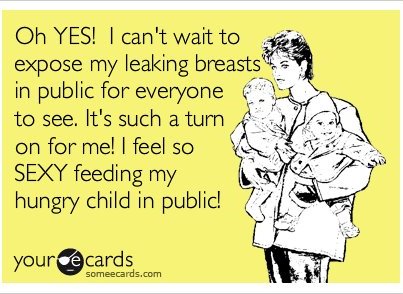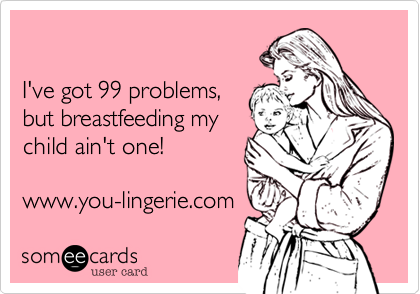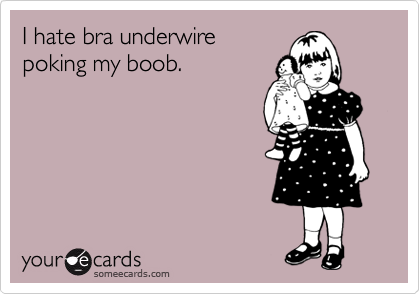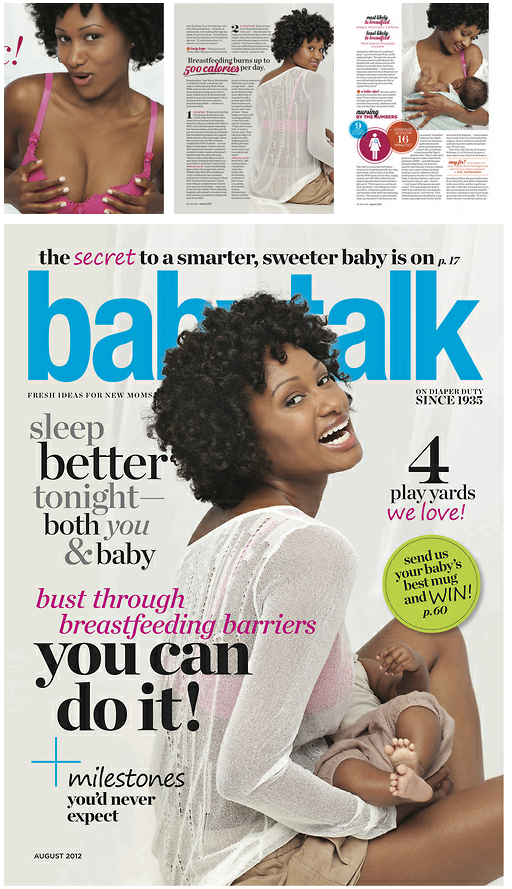Archive of ‘Blog’ category
 While nursing in public is often criticized, this criticism is unfounded and stems mainly from people’s cultural beliefs. Breastfeeding in public is legal in the United States, regardless of where you are1. Because nursing is the primary function of your breasts, and hungry babies are impatient and will not wait to get home to eat, you should nurse your baby when she needs it, even if you are at the mall. That being said, it helps to always offer her your breast before leaving home.
While nursing in public is often criticized, this criticism is unfounded and stems mainly from people’s cultural beliefs. Breastfeeding in public is legal in the United States, regardless of where you are1. Because nursing is the primary function of your breasts, and hungry babies are impatient and will not wait to get home to eat, you should nurse your baby when she needs it, even if you are at the mall. That being said, it helps to always offer her your breast before leaving home.
Unless you stay home throughout your entire nursing relationship, you will undoubtedly have to nurse in public every now and then. If you are uncomfortable with public breastfeeding, here are a few ideas that will make it easier.
- Always wear a nursing top and a nursing bra when going out with your infant, even if you don’t plan on being out long – you never know when your baby is going to need a meal. Having easy access to your breasts is key. People will look at you, and having to pull your shirt up and get your breast to come out of a full coverage bra can be quite awkward. Nursing bras have convenient snaps on their straps and nursing tops are usually looser and are designed to provide quick access, so you will reveal surprisingly little skin.
- Keep a nursing cover in your diaper bag. If you are not comfortable with passers by looking at your baby while he is eating his lunch, you can try using a nursing cover. Some babies are principally against them though.
- Keep a Boppy pillow in the car. Nursing in the back seat of your car at a grocery store parking lot can be very convenient, especially if you have a Boppy pillow – a “U”-shaped pillow that fits around your waist. It allows your baby to get comfortable and gives your arms a break.
- La Leche League suggests being on the lookout for convenient spots to breastfeed your baby when arriving at a new public place. It will save you the hassle of running around with a crying infant, looking for a perfect place to nurse2.
All other things aside, your baby’s health and well-being are most important, regardless of who is looking at you and what they may be thinking.
1Anne Robb Pugliese. (2000, December). LLLI-Breastfeeding in Public. Retrieved July 1, 2012, from, La Leche League: http://www.llli.org/nb/nbnovdec00p196.html
2 Michaelene Gerster Trocola. (2005, December). LLLI-Breastfeeding in Public. Retrieved July 30, 2012, from La Leche League: http://www.llli.org/nb/nbnovdec05p238.html
 You know that breastfeeding is best for your baby, but what do you do when you encounter challenges? If things don’t go as planned, don’t worry – many nursing mothers experience one or more of these problems.
You know that breastfeeding is best for your baby, but what do you do when you encounter challenges? If things don’t go as planned, don’t worry – many nursing mothers experience one or more of these problems.
Breast engorgement (painful swelling of breasts) is the most common breastfeeding problem and is completely natural. It occurs when breasts are not emptied adequately. Some women produce more breast milk than others and experience engorgement more frequently. Breast engorgement may interfere with breastfeeding because your baby may not be able to latch on properly. The best remedy for engorgement is to nurse your baby frequently and to express extra milk by pump or hand when your little one isn’t hungry. MedlinePlus, a service of the US National Library of Medicine, recommends taking warm showers and using cold compresses to treat engorgement (MedLine, 2012).
Sore nipples are another common problem for breastfeeding mothers, especially when they first begin nursing. Since sore and cracked nipples are usually caused by an improper latch, they usually heal as soon as your baby learns to latch on properly. You may need to enlist the help of a professional lactation consultant to correct your baby’s latch. Otherwise, you may be unable to continue breastfeeding due to pain. To relieve pain and help cracked nipples heal faster, use clean warm water and lanolin ointment.
Another frequent breastfeeding problem involves plugged ducts. According to Wolters Kluwer Health, “Plugged ducts are areas in the breast where the flow of milk is blocked, usually by plugs of skin cells and milk. As the milk duct fills and stretches, the surrounding breast tissue becomes tender” (Schenler & Enger, 2010). Plugged ducts can be large and painful and you should contact your doctor if your condition doesn’t improve within a few days. The best way to treat plugged ducts at home is by nursing more often on the affected breast and gentle breast massage.
Mastitis (breast infection) is a painful condition that usually occurs two to three weeks after giving birth due to cracked nipples or plugged milk ducts, and is frequently accompanied by fever and other flu-like symptoms, says Sharon Mass, a doctor from the American College of Obstetricians and Gynecologists’ (Amy Sirot, Parents Magazine, 2012). This condition causes a part of your breast to become red, engorged and hot. Mastitis often requires a treatment with antibiotics. You should continue breastfeeding your baby, as well as get rest and drink plenty of water. Always contact your doctor if you experience any symptoms of mastitis.
If you experience engorgement, plugged ducts or mastitis, be sure to wear a comfortable nursing bra and avoid underwire bras or bras that are too tight.
Amy Sirot, Parents Magazine. (2012). Nursing Roadblocks. Retrieved June 23, 2012, from Parents
MedLine. (2012). MedlinePlus-Health Information From The National Library of Medicine. Retrieved June
Schenler, R. J., & Enger, L. (2010, August 9). Patient information: Common breastfeeding problems
 Many women enjoy the support and form that underwire bras provide, but are they safe for nursing mothers? While most experts don’t outright rule out underwire bras, they recommend avoiding them in the last months of pregnancy and while breastfeeding.
Many women enjoy the support and form that underwire bras provide, but are they safe for nursing mothers? While most experts don’t outright rule out underwire bras, they recommend avoiding them in the last months of pregnancy and while breastfeeding.
Riverview Hospital Association (of Wisconsin Rapids, WI) says this with regard to underwire nursing bras, “Underwire bras can contribute to plugged ducts. If you choose to wear one, it is very important that the band of the wire falls beneath the natural crease where the breast meets the rib cage.” 1 Botsford Hospital also strongly cautions against using underwire nursing bras, citing not only plugged ducts, but restricted milk flow as potential dangers.2
Dr. Sears recommends avoiding underwire nursing bras as well, especially for the first few weeks postpartum. “The breast’s milk-producing tissue extends all the way back to your rib cage and up into your armpit,” says Sears, “An underwire may obstruct the milk ducts in this area–besides poking and annoying you.”2 California Pacific Medical Center also recommends avoiding underwire bras for the same reasons.3
It seems to be the consensus of the medical community that underwire bras are not a good choice for nursing mothers. It is best to opt for soft bras that are comfortable and won’t restrict milk flow.
1Riverview Hospital Association. (2012). Clothing and Nursing Bras. Retrieved on April 23, 2012 from http://www.rhahealthcare.org/clothingnursingbras.pdf
2 Ask Dr. Sears. (2012). Choosing the Right Nursing Bra. Retrieved on April 22, 2012 from http://www.askdrsears.com/topics/breastfeeding/helpful-products/choosing-right-nursing-bra
3Botsford Hospital Breastfeeding Services. (2012). How to Buy a Good Bra. Retrieved on April 23, 2012 from http://www.botsford.org/medical_services/new_beginnings_maternity/breastfeeding/Breastfeeding_How_to_buy_a_good_bra.pdf
4California Pacific Medical Center. (2012). Common Problems & Concerns About Breastfeeding. Retrieved on April 23,2012 from http://www.cpmc.org/services/pregnancy/information/breastfeeding-concerns.html
We are beyond thrilled to have our Ella Rose nursing bra be featured on the cover and several pages of the August issue of BabyTalk Magazine. This issue discusses “Breastfeeding Barriers” and we LOVE that it also shows that breastfeeding can be CHIC and BEAUTIFUL!!!
Whooohoooo!!! 

- You! Lingerie’s Ella Rose Nursing bra featured in the August issue of BabyTalk Magazine
 If you’ve never bought a nursing bra before, shopping for one may seem like a daunting task. What size should you buy? How do you know whether it’s going to fit you throughout your nursing experience? Below are a few basic guidelines to get you started.
If you’ve never bought a nursing bra before, shopping for one may seem like a daunting task. What size should you buy? How do you know whether it’s going to fit you throughout your nursing experience? Below are a few basic guidelines to get you started.
First of all, you should start shopping before your baby arrives and get fitted by a certified bra fitter. If you plan on purchasing nursing bras online, you can still get fitted at the maternity store and write down your measurements for future use.
When choosing a nursing bra, keep in mind comfort and convenience. For comfort, look for a soft, well fitting bra. Bras that are too tight are not only uncomfortable, but may contribute to plugged ducts.1 WebMD recommends wearing nursing bras that provide firm support for the growing breasts.2 Babycenter.com, a trusted pregnancy and parenting resource recommends looking for soft cotton or cotton-synthetic blend nursing bra that doesn’t have seems near the nipple and has sturdy, wide straps.3 Dr. Sears suggests choosing a bra that “supports the breast from beneath even when the cup is open.”1
A guide from Botsford Hospital Breastfeeding Services says this about buying a nursing bra:
- Choose cotton, because it allows the air to circulate around your breasts and prevents irritation;
- Choose wide straps, because they won’t cut into your shoulders;
- Try to avoid underwire bras, as they may interfere with the flow of milk;
- Look for a bra with fasteners that can easily be opened and closed with one hand.4
If you are going to pump as well as nurse, you may benefit from buying a special bra that allows for a pumping attachment. This type of bra will give you the freedom to pump hands-free.
When you try on bras, sit down to check how the bra fits and feels when you change position. Also, practice opening and closing the bra fastener in the fitting room. You may need to try on several different bras before you find the perfect fit. Your rib cage expands throughout pregnancy, so if you bought your nursing bra while pregnant, you may need to size up a few times after giving birth.
1 Ask Dr. Sears. (2012). Choosing the Right Nursing Bra. Retrieved on April 22, 2012 from http://www.askdrsears.com/topics/breastfeeding/helpful-products/choosing-right-nursing-bra
2 WebMD. (2012). Common Pregnancy Pains and Their Causes. Retrieved on April 23, 2012 from http://www.webmd.com/baby/guide/pregnancy-coping-with-discomforts
3 BabyCenter. (2012). Maternity and nursing bras 101. Retrieved on April 23, 2012 from http://www.babycenter.com/0_maternity-and-nursing-bras-101_10347729.bc?page=2
4 Botsford Hospital Breastfeeding Services. (2012). How to Buy a Good Bra. Retrieved on April 23, 2012 from http://www.botsford.org/medical_services/new_beginnings_maternity/breastfeeding/Breastfeeding_How_to_buy_a_good_bra.pdf
 While nursing in public is often criticized, this criticism is unfounded and stems mainly from people’s cultural beliefs. Breastfeeding in public is legal in the United States, regardless of where you are1. Because nursing is the primary function of your breasts, and hungry babies are impatient and will not wait to get home to eat, you should nurse your baby when she needs it, even if you are at the mall. That being said, it helps to always offer her your breast before leaving home.
While nursing in public is often criticized, this criticism is unfounded and stems mainly from people’s cultural beliefs. Breastfeeding in public is legal in the United States, regardless of where you are1. Because nursing is the primary function of your breasts, and hungry babies are impatient and will not wait to get home to eat, you should nurse your baby when she needs it, even if you are at the mall. That being said, it helps to always offer her your breast before leaving home.
 You know that breastfeeding is best for your baby, but what do you do when you encounter challenges? If things don’t go as planned, don’t worry – many nursing mothers experience one or more of these problems.
You know that breastfeeding is best for your baby, but what do you do when you encounter challenges? If things don’t go as planned, don’t worry – many nursing mothers experience one or more of these problems.


 If you’ve never bought a nursing bra before, shopping for one may seem like a daunting task. What size should you buy? How do you know whether it’s going to fit you throughout your nursing experience? Below are a few basic guidelines to get you started.
If you’ve never bought a nursing bra before, shopping for one may seem like a daunting task. What size should you buy? How do you know whether it’s going to fit you throughout your nursing experience? Below are a few basic guidelines to get you started.